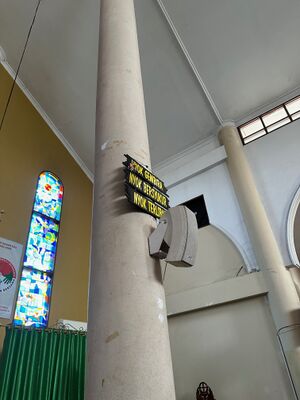اللغة البتاوية
| Betawi | |
|---|---|
| basè Betawi, basa Betawi | |
| موطنها | Indonesia Australia |
| المنطقة | Jakarta West Java Banten Cocos (Keeling) Islands |
| العرق | |
الناطقون الأصليون | (5 million cited 2000 census)e18 |
Malay-based creole
| |
| اللهجات |
|
| أكواد اللغات | |
| ISO 639-3 | bew |
| Glottolog | beta1252 |
Betawi, also known as Betawi Malay, Jakartan Malay, or Batavian Malay is the spoken language of the Betawi people in Jakarta, Indonesia. It is the native language of perhaps 5 million people; a precise number is difficult to determine due to the vague use of the name.
Betawi Malay is a popular informal language in contemporary Indonesia, used as the base of Indonesian slang and commonly spoken in Jakarta TV soap operas and some animated cartoons (e.g. Adit Sopo Jarwo).[1] The name "Betawi" stems from Batavia, the official name of Jakarta during the era of the Dutch East Indies. Colloquial Jakarta Indonesian, a vernacular form of Indonesian that has spread from Jakarta into large areas of Java and replaced existing Malay dialects, has its roots in Betawi Malay. According to Uri Tadmor, there is no clear border distinguishing Colloquial Jakarta Indonesian from Betawi Malay.[2]
. . . . . . . . . . . . . . . . . . . . . . . . . . . . . . . . . . . . . . . . . . . . . . . . . . . . . . . . . . . . . . . . . . . . . . . . . . . . . . . . . . . . . . . . . . . . . . . . . . . . . . . . . . . . . . . . . . . . . . . . . . . . . . . . . . . . . . . . . . . . . . . . . . . . . . . . . . . . . . . . . . . . . . . .
خلفية
The origin of Betawi is of debate to linguists; many consider it to be a Malay dialect descended from Proto-Malayic, while others consider it to have developed as a creole. It is believed that descendants of Chinese men and Balinese women in Batavia converted to Islam and spoke a pidgin that was later creolized, and then decreolized incorporating many elements from Sundanese and Javanese (Uri Tadmor 2013).[3]
Betawi has large amounts of Hokkien Chinese, Arabic, Portuguese, and Dutch loanwords. It replaced the earlier Portuguese creole of Batavia, Mardijker. The first-person pronoun gua ('I' or 'me') and second-person pronoun lu ('you') and numerals such as cepek ('a hundred'), gopek ('five hundred'), and seceng ('a thousand') are from Hokkien, whereas the words ane ('I' or 'me') and ente ('you') are derived from Arabic. Cocos Malay, spoken in the Cocos (Keeling) Islands, Australia and Sabah, Malaysia is believed to have derived from an earlier form of Betawi Malay.
اللهجات

Betawian Malay is divided into two main dialects;
- Middle Betawi dialect: Originally spoken within Jakarta with a greater use of e (e.g. ada becomes ade).
- Suburban Betawi dialect: Originally spoken in suburban Jakarta, Tangerang in Banten, Depok, Bogor, and Bekasi in West Java. It has a greater use of extended a (e.g. ada, pronounced adah).
Another Suburban Betawi variant is called Betawi Ora, which was highly influenced by Sundanese.
Betawi is still spoken by the older generation in some locations on the outskirts of Jakarta, such as Kampung Melayu, Pasar Rebo, Pondok Gede, Ulujami, and Jagakarsa.[4]
There is a significant Chinese community which lives around Tangerang, called Cina Benteng, who have stopped speaking Chinese and now speak Betawian Malay.
أمثلة:
- ane (formal), aye (middle), sayah (suburban), gua (informal): 'I'
- ente (formal), lu (informal or intimate): 'you'
- iye (strong e, not schwa like Johor and Riau accent), iyah: 'yes'
- kaga, ora (udik variant): 'no'
- Encing mo pegi ke mane?: 'Where will you go, uncle?'
- Dagangan aye udeh beres, dah: 'My stuff has been sold out.'
The ending of every Betawi word that ends with an "a" is pronounced "e" like in the English word net. The "e" is pronounced in a way different from the way Johor and Riau Malays pronounce it.
عينة

الإنجليزية
All human beings are born free and equal in dignity and rights. They are endowed with reason and conscience and should act towards one another in a spirit of brotherhood.
الملايو
Semua manusia dilahirkan bebas dan samarata dari segi kemuliaan dan hak-hak. Mereka mempunyai pemikiran dan perasaan hati dan hendaklah bertindak di antara satu sama lain dengan semangat persaudaraan.
بتاوي
Semue orang ntu dilahirin bebas ame punye martabat dan hak-hak yang same. Mereka ntu dikasih akal ame ati nurani dan kudu bergaul satu ame lainnye dalem semangat persaudaraan.
انظر أيضاً
المراجع
- ^ "Towards an account of information structure in Colloquial Jakarta Indonesian" in Proceedings of the International Workshop on Information Structure of Austronesian Languages, 10 April 2014., Research Institute for Languages and Cultures of Asia and Africa, Tokyo University of Foreign Studies.
- ^ Kozok, Uli (2016), Indonesian Native Speakers – Myth and Reality, p. 15, https://indonesian-online.com/wp-content/uploads/2016/08/Native-Speakers.pdf
- ^ Tadmor, Uri (2013). "On the Origin of the Betawi and their Language" (PDF). ISMIL 17 conference talk.
- ^ "Documentation of Betawi". Max Planck Institute for Evolutionary Anthropology, Leipzig. Archived from the original on 2013-12-03. Retrieved 2021-02-06.
ببليوجرافيا
- Ikranagara, Kay (1975). Melayu Betawi grammar (Ph. D. thesis). University of Hawaii at Manoa. hdl:10125/11720.

